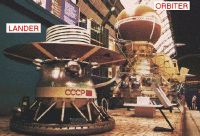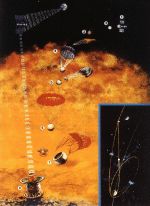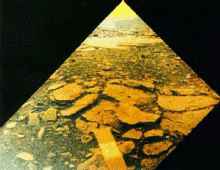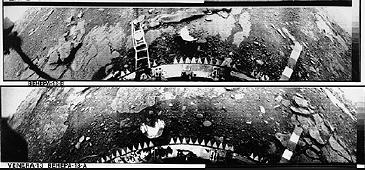Venera Venus Landers


Venera 7
Venera 8
Venera 9
Venera 10
Venera 11
Venera 12
Venera 13
Venera 14
Photos of the surface of Venus
Venera 7
Launch Date: 1970-08-17
Description:
Venera 7 was launched from a Tyazheliy Sputnik towards Venus to study the Venusian atmosphere
and other phenomena of the planet. Venera 7 entered the atmosphere of Venus on December 15,
1970, and a landing capsule was jettisoned. After aerodynamic braking, a parachute system was
deployed. The capsule antenna was extended, and signals were returned for 35 minutes. Another 23
minutes of very weak signals were received after the spacecraft landed on Venus. The capsule was
the first man-made object to return data after landing on another planet.
Venera 8
Launch Date: 1972-03-18
Description:
Venera 8 successfully landed a probe that survived for 50 minutes.
The probe, which was the first to land on the day side, returned data on light levels and soil density.
It also measured wind speed variations during descent of:
100 meters/second (224 miles per hour) above 48 kilometers (30 miles);
40 to 47 meters/second (89 miles per hour) at 42 to 48 kilometers (26 to 30 miles), and,
1 meter/second (2 miles per hour) below 10 kilometers (6 miles).
Venera 9
Launch Date: 1975-06-08
Description:
On October 20, 1975, this spacecraft was separated from the Orbiter, and landing was made with
the sun near zenith at 0513 UT on October 22. A system of circulating fluid was used to distribute
the heat load. This system, plus precooling prior to entry, permitted operation of the spacecraft for
53 min after landing. During descent, heat dissipation and deceleration were accomplished
sequentially by protective hemispheric shells, three parachutes, a disk-shaped drag brake, and a
compressible, metal, doughnut-shaped, landing cushion. The landing was about 2,200 kilometers
from the Venera 10 landing site. Preliminary results indicated: (A) clouds 30-40 kilometers thick with
bases at 30-35 kilometers altitude, (B) atmospheric constituents including HCl, HF, Br, and I, (C)
surface pressure about 90 (earth) atmospheres, (D) surface temperature 485 deg C, (E) light levels
comparable to those at earth midlatitudes on a cloudy summer day, and (F) successful TV
photography showing shadows, no apparent dust in the air, and a variety of 30-40 cm rocks which
were not eroded.
Venera 10
Launch Date: 1975-06-14
Description:
On October 23, 1975, this spacecraft was separated from the Orbiter, and landing was made with
the sun near zenith, at 0517 UT, on October 25, 1975. A system of circulating fluid was used to
distribute the heat load. This system, plus precooling prior to entry, permitted operation of the
spacecraft for 65 minutes after landing. During descent, heat dissipation and deceleration were
accomplished sequentially by protective hemispheric shells, three parachutes, a disk-shaped drag
brake, and a compressible, metal, doughnut-shaped, landing cushion. The landing was about 2,200
kilometers from Venera 9. Preliminary results provided: (A) profile of altitude (kilometers)/pressure
(Earth atmospheres)/temperature (degrees Celcius) of 42/3.3/158, 15/37/363, and 0/92/465, (B)
successful TV photography showing large pancake rocks with lava or other weathered rocks in
between, and (C) surface wind speed of 3.5 m/s.
Venera 11
Launch Date: 1978-09-09
Description:
The Venera 11 descent craft carried instruments designed to study the detailed chemical composition
of the atmosphere, the nature of the clouds, and the thermal balance of the atmosphere. Separating
from its flight platform on December 25, 1978, it made a soft landing on the surface after a descent
time of approximately 1 hour. During this time, it employed aerodynamic braking followed by
parachute braking and ending with atmospheric braking. The touchdown speed was 7-8 m/s.
Information was transmitted to the flight platform for retransmittal to Earth. It is unknown whether the
Lander Probe carried an imaging system.
Venera 12
Launch Date: 1978-09-14
Description:
The Venera 12 descent craft carried instruments designed to study the detailed chemical composition
of the atmosphere, the nature of the clouds, and the thermal balance of the atmosphere. Separating
from its flight platform on December 21, 1978, it made a soft landing on the surface after a descent
time of approximately 1 hour. During this time, it employed aerodynamic braking followed by
parachute braking and ending with atmospheric braking. The touchdown speed was 7-8 m/s.
Information was transmitted to the flight platform for retransmittal to earth. It is unknown whether the
Lander Probe carried an imaging system.
Venera 13
Launch Date: 1981-10-30
Description:
Venera 13 landed at 7° 30 minutes South by 303°, just east of the eastern extension of an elevated
region known as Phoebe Regio. It survived for 2 h 7 min in an environment with a temperature of
457°C and a pressure of 89 earth atmospheres. Venera 13 carried instruments to take chemical and
isotopic measurements, monitor the spectrum of scattered sunlight, and record electric discharges
during its descent phase through the Venusian atmosphere. The spacecraft utilized a camera system,
an X-ray fluorescence spectrometer, and a seismometer to conduct investigations on the surface.
Venera 14
Description:
Venera 14 landed at 13° 15 minutes S by 310°, about 950 kilometers southwest of Venera 13.
Surface temperature was 465°C and pressure was 94 Earth atmospheres. Venera 14 carried
instruments to take chemical and isotopic measurements, monitored the spectrum of scattered
sunlight, and recorded electric discharges during its descent phase through the Venusian atmosphere.
The spacecraft utilized a camera system, an X-ray fluorescence spectrometer, and a seismometer to
conduct investigations on the surface.
Some photos taken by Venera 13
Phoebe Regio, Venus

Enhanced portion of the right side of the image below

135-degree panoramic sweep. Camera is facing north.

The top B/W image is is
a 135 degree panoramic sweep with the camera facing south. The robot
arm of the spacecraft, used to collect soil samples, is clearly visible. The bottom B/W image is the same as the color one above.
Back to the Space Exploration page






